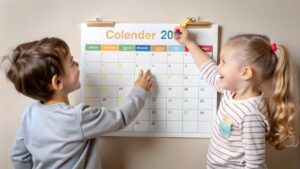The Education Blog

How to Create a Homeschool Portfolio for Reviews or Colleges
Imagine this You’re sitting across from a university admissions officer, and instead of being met with scepticism about your homeschooling journey, you’re handed a compliment—”This is the most organised and insightful portfolio we’ve seen all year.”
That’s the power of a well-crafted homeschool portfolio.
Whether you’re preparing for annual state reviews or showcasing your child’s education to future universities, a strong portfolio bridges the gap between informal learning and formal evaluation. It offers a tangible narrative of your child’s growth, achievements, and academic readiness.
This homeschool portfolio template guide will walk you through the process of building a powerful, organised, and college-ready homeschool record—without stress or second-guessing.
Understanding the Core: What Is a Homeschool Portfolio?
A homeschool portfolio is a curated collection of your child’s work, progress, and experiences. Think of it as a scrapbook meets transcript—it documents your teaching methods, educational goals, and academic output. For parents in states requiring annual evaluations, it’s often mandatory. For families eyeing college applications, it becomes essential.
There are typically two major purposes:
- State or local education review To demonstrate compliance with legal homeschooling requirements.
- College admissions To show academic preparedness, extracurricular involvement, and learning depth.
A quality portfolio usually includes samples of academic work, progress records, reading lists, extracurriculars, and sometimes even reflections or goals set by the student.
According to HSLDA (Home School Legal Defense Association), well-documented education portfolios can enhance a student’s application and provide a competitive edge when applying to selective institutions.
Quick Guide: Homeschool Portfolio Essentials
Quick Guide: Core Elements of a Homeschool Portfolio
- Cover page with student details and homeschool overview
- Yearly academic summary or learning goals
- Samples of work (essays, art, tests, worksheets)
- Subject-by-subject summaries
- Reading lists and curriculum used
- Extracurricular activities and community involvement
- Assessment results or progress evaluations
- Certifications, awards, or special recognitions
- Reflections or learning logs (optional)
- A transcript or course credit summary (for older students)
Step-by-Step Guide: How to Build a College-Ready Homeschool Portfolio
1. Start with a Strong Cover Page
This is your portfolio’s first impression. It should include:
- Student’s full name and age
- Academic year (e.g., 2024–2025)
- Grade level
- Parent educator contact details
- Optional A brief philosophy of education or learning statement
Pro Tip: Use a clean, minimalist design and include a photo of your child for a personal touch.
2. Outline the Year’s Learning Objectives
Add a one-page summary describing:
- Subjects covered
- Key learning goals
- Teaching methods or approach (e.g., Charlotte Mason, classical, unit-based)
- Flexibility for interest-led exploration
This sets context for reviewers or admissions staff and shows intentional planning.
3. Include Subject-by-Subject Summaries
Break down each core subject (Maths, Science, English, History, etc.).
- Curriculum used
- Key topics covered
- Highlighted projects or units
- Assessments or evaluation style (e.g., narrative, percentage-based)
For each subject, you can also include:
- 2–3 samples of student work
- A photograph of hands-on projects or lab experiments
- Rubrics, if used for grading
4. Document Extracurriculars and Enrichment Activities
Colleges and evaluators are keen to see well-rounded students. Include:

- Sports, arts, drama, or music lessons
- Volunteer work
- Field trips and educational outings
- Co-op classes or group sessions
If you’re not sure how to plan meaningful outings.
how-to-plan-a-homeschool-field-trip-that’s-educational-and-fun
5. Add Reading Lists
Record all required and pleasure-reading books read throughout the year. You might include:
- Title, author, and date completed
- A short reflection from your child
- Thematic grouping (e.g., British literature, historical fiction)
Important: For advanced readers, note grade level or difficulty.
6. Showcase Progress Over Time
Include:
- Beginning-of-year assessments or reflections
- Mid-year check-ins
- End-of-year summary or parent evaluation
- Standardised test scores (if applicable)
You can use spreadsheets, graphs, or anecdotal notes to track progress.
7. Prepare a Transcript (for High School Students)
For college-bound students, a formal transcript is non-negotiable. Include:
- Course names
- Credits earned
- Grade or evaluation
- GPA (if using one)
You might also note dual-enrolment courses or community college participation.
Important Notes & Warnings
Pro Tip: Organise portfolios in both digital and physical formats. Use cloud storage (e.g., Google Drive) and a printed binder with dividers.
Warning: Avoid over-cluttering. Focus on quality over quantity—choose work samples that best represent your child’s abilities and improvement.
Best Practices & Additional Insights

Tailor for the Audience
If you’re preparing for an annual review, clarity and thoroughness are key. For college admissions, storytelling matters—showcase personality, passion, and achievement.
Use Case: A homeschooled student interested in environmental science included a section on their composting project, community clean-up events, and self-designed biology experiments. It painted a vivid picture that resonated with university reviewers.
Important Tip: Check your state’s legal requirements for homeschool documentation to ensure compliance.
Use a Flexible Template
A great homeschool portfolio template should be adaptable by grade and goal. Create or download one that includes editable sections for work samples, reflections, and learning goals.
Tip: Include a section that explains how your homeschool operates—whether you follow a traditional calendar or a year-round approach.
You can structure the portfolio to align with how you keep kids motivated during homeschooling, adding sections that celebrate progress and unique talents.
Check out our guide on how-to-keep-kids-motivated-during-homeschooling
FAQs
What is a homeschool portfolio template?
A homeschool portfolio template is a structured format or layout that helps parents organise their child’s academic records, work samples, and other educational documentation.
Do all homeschoolers need a portfolio?
Not always. Requirements vary by country and state. However, portfolios are useful even when not mandatory—for self-assessment, motivation, or college applications.
How long should a homeschool portfolio be?
Aim for 20–40 pages. It should be comprehensive yet concise, representing a full year of learning without being overwhelming.
Can digital portfolios replace physical ones?
Yes. Digital portfolios (PDFs, cloud folders, shared drives) are increasingly accepted by reviewers and colleges—just ensure files are well-labelled and navigable.
When should I start building a portfolio?
Start from the beginning of the academic year. Regularly collect and sort materials instead of scrambling to compile everything at once.
Build a Portfolio That Tells a Story of Growth
Your homeschool portfolio is more than a record—it’s a showcase of your child’s journey, resilience, and individuality. Whether you’re preparing for reviews or paving a path toward higher education, thoughtful documentation makes all the difference.
By using a clear structure, relevant samples, and a consistent tone, you’ll ensure that your portfolio stands out—for all the right reasons.
Start today: Download a homeschool portfolio template, review your goals, and begin collecting those moments of learning that matter most.









